#dicyemidae
Explore tagged Tumblr posts
Text
Favourite animals poll! Round 5
Now a new round, concerning families of...

Mesozoans, which won the previous round.
#favourite animals poll#round 5#animals poll#animals#poll#polls#favourite creatures poll#creatures#mesozoans#conocyemidae#dicyemidae#kantharellidae
1 note
·
View note
Text
Phylum Round 1

Dicyemida (Rhombozoa): A small phylum of wormlike parasites specialized to live in the kidneys of cephalopods. While its evolutionary relationships are still being debated, it is believed that they are closely related to Orthonectida. They reproduce asexually in their host until they reach a certain population density, at which point new larvae will grow into an adult form that will reproduce sexually.
Chaetognatha: Arrow Worms. Widespread marine animals, Chaetognaths can be described as the "apex predators" of the plankton. Despite their microscopic size, their muscle movements are some of the fastest in the animal kingdom. All Chaetognaths are ambush predators, feeding on small zooplankton and even fish and crustacean larvae. Some utilize neurotoxins to paralyze their prey after capture in their spiny jaws.
#micro royale#worm on worm violence#cw parasites#dicyemida#chaetognatha#animal bracket#tumblr bracket#bracket tournament#poll bracket#phylum round 1#phylum
51 notes
·
View notes
Text
Taxonomy Tournament: Spiralia


Dicyemida. This phylum is made of tiny parasites that live in the kidneys of cephalopods
Monoblastozoa. This phylum of animals has only one member, Salinella salve, which was only ever described in the 1890s and hasn't been found since.
#animals#biology#polls#poll tournament#zoology#animal parasite#spiralia#lost media#Dicyemida#Monoblastozoa#0x31v0xce#animal tournament#Animal Tournament Round 1
38 notes
·
View notes
Text
Round 1 Final Stats:
The top phyla have been ranked thusly, listed here from highest ranking to lowest:
🪲 Arthropoda ~ 2,002
🐠 Chordata ~ 1,780
🐌 Mollusca ~ 1,687
🪸 Cnidaria ~ 1,307
🫓 Platyhelminthes ~ 1,217
🔫 Onychophora ~ 1,180
🔬 Tardigrada ~ 1,101
🌈 Ctenophora ~ 1,013
⭐️ Echinodermata ~ 947
🪱 Annelida ~ 681
🧽 Porifera ~ 535
👥 Bryozoa ~ 331
⚪️ Placozoa ~ 328
⛱ Brachiopoda ~ 303
⚙️ Rotifera ~ 298
🍆 Priapulida ~ 216
🧲 Phoronida ~ 178
🌍 Nematoda ~ 169
🐉 Kinorhyncha ~ 169
🌰 Hemichordata ~ 169
🎉 Loricifera ~ 147
🎗 Nemertea ~ 138
❄️ Micrognathozoa ~ 124
🧪 Xenacoelomorpha ~ 123
🍴 Entoprocta ~ 111
👛 Cycliophora ~ 110
🦷 Gnathostomulida ~ 100
🏹 Chaetognatha ~ 83
🧶 Gastrotricha ~ 82
🐙🔍 Dicyemida ~ 19
🦪🔍 Orthonectida ~ 12
🐴✂️ Nematomorpha ~ -37
The top 3 phyla are Arthropoda, Chordata, and Mollusca!
This means Arthropoda, Chordata, and Mollusca will be moving on to Round 2, and broken up by Class (or some other phylogenetic equivalent).
But that’s not all!
After Round 2, we will have an extra Round 2.5, featuring every other phylum that received over 1,000 points! This will give some of the more highly ranked phyla a second chance to move on, and make Round 3 a little more interesting.
Round 2.5 will include Cnidaria, Platyhelminthes, Tardigrada, and Ctenophora.
(Unfortunately, I can’t include Onychophora as it only contains 2 families without class or order ranking, so I will have to preemptively move them forward to Round 4 ¯\_(ツ)_/¯)
To give myself enough time to queue up polls, Round 2 will begin November 1st.
See you then!
Extra Awards:
Phylum Porifera
~ had the highest percentage of likes at 50.8%
Phylum Placozoa
~ had the highest amount of neutral votes at 295
Phylum Xenacoelomorpha
~ had 0 hates
Phylum Platyhelminthes
~ had the most votes at 620
~ had the highest amount of loves at 245
~ had the highest amount of likes at 204
Phylum Gastrotricha
~ had the lowest amount of favorites at 2
~ had the lowest percentage of favorites at 0.7%
Phylum Mollusca
~ had 0 dislikes
~ had the third most reblogs at 86
Phylum Entoprocta
~ had 0 hates
Phylum Phoronida
~ had 0 hates
Phylum Orthonectida
~ had the lowest amount of likes at 20
~ had the least notes at 17
~ had the least reblogs at 6
Phylum Dicyemida
~ had the least votes at 158
~ had the lowest amount of loves at 4
~ had the lowest percentage of loves at 2.5%
~ had the highest percentage of neutral votes at 67.9%
Phylum Micrognathozoa
~ was our first single species to be ranked
~ had 0 hates
Phylum Rotifera
~ had 0 hates
Phylum Nematomorpha
~ had the highest amount of dislikes at 74
~ had the highest percentage of dislikes at 30.1%
~ had the highest percentage of hates at 11.4%
~ was the only phylum with a negative ranking
Phylum Onychophora
~ had the most notes at 310
~ had the most reblogs at 115 (though a lot of them happened after the poll closed)
Phylum Arthropoda
~ was the only phylum to get over 2,000 points
~ had the second most reblogs at 101
~ had 0 hates
Phylum Echinodermata
~ had the highest percentage of loves at 52.8%
~ was the only phylum to not receive any dislikes or hates
Phylum Chordata
~ had the highest amount of favorites at 334
~ had the highest percentage of favorites at 71.5%
~ had the lowest percentage of likes at 4.9%
~ had the lowest percentage of neutral votes at 0.6%
~ had the highest amount of hates at 37
#clearly there is a direct correlation between reblogs and votes!#chordata had the highest amount of favorites yes but Arthropoda had more votes and the positive votes add up!#and that was because more people reblogged the Arthropoda poll#anyway thank you all for voting!#hopefully I have given myself enough time and also y’all won’t lose interest by November#i run a paleoart challenge in November which will be taking up most of my time so i want to make sure I at least have all of November#queued up in advance#i’ll still be active here to answer questions and post extr propaganda though!#Statistics#extras#poll results#round 1
152 notes
·
View notes
Text
The Weird Microorganism Iceberg
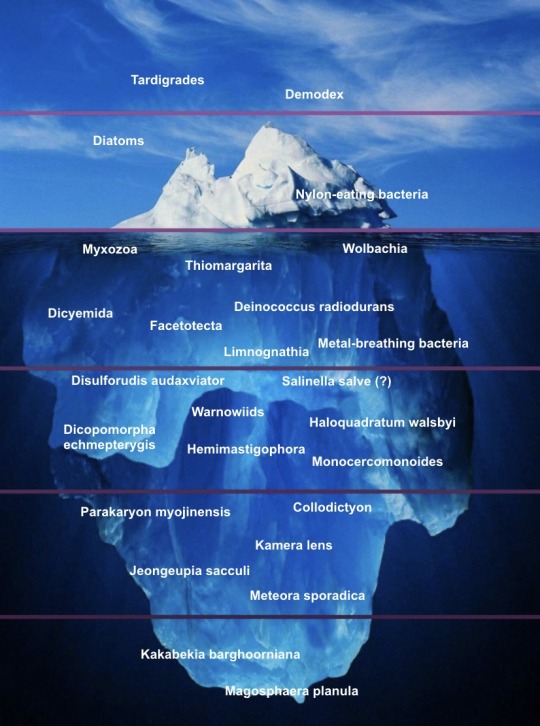
I basically made this on an impulse, please don’t take it too seriously. Feel free to suggest more organisms!
Explanations under the cut.
Tardigrades: You probably all know this one. Commonly said to be polyextremophiles, but this isn’t actually true; while they can survive extreme conditions, they don’t thrive in them. Something you might not know about them is that all of their body segment genes are equivalent to arthropod head genes — meaning they are basically walking heads.
Demodex: Eyelash mites.
Diatoms: Geometric silicon shell creatures.
Nylon-eating bacteria (Paenarthrobacter ureafaciens KI72): Exactly what it says on the tin.
Myxozoa: Single-celled parasitic cnidarians. Lack digestive systems, circulatory systems, gonads, and even muscles in some species. Also may or may not be autonomous cancer cells.
Thiomargarita: The only macroscopic bacteria. Honorary microorganisms for the purposes of this image.
Wolbachia: Parasitic / mutualistic bacteria genus that has created numerous insect species through their effects on reproduction. (Infected females can become capable of parthenogenesis, while infected males are either killed, turned into females, or limited to reproducing only with females infected by the same strain.)
Deinococcus radiodurans: A bacterium which unofficially holds the title of “most extreme extremophile”. Can survive incredibly high doses of radiation, as well as high acidity and very low temperatures.
Dicyemida: Symbiotic (once mistakenly thought to be parasitic) animals that live in cephalopod kidneys. Have alternation of generations and used to be known as “Rhombozoa” (“rhombus animals”).
Facetotectans: Parasitic crustaceans with an unknown adult form. Attempts to artificially induce metamorphosis only produce another juvenile stage, as far as anyone can tell.
Metal-breathing bacteria: Bacteria which use nanowires to accept electrons from metals.
Limnognathia: One of the smallest animals, and has 15-part extensible jaws.
Disulforudis audaxviator: The only known organism to comprise a single-species ecosystem. Lives over a mile underground and feeds off the byproducts of radioactive decay.
Salinella salve: Possibly nonexistent simple animal, allegedly cultured by Johannes Frenzel in 1892 but never found by anyone else.
Warnowiids (Warnowiaceae): A family of dinoflagellates which have modified some of their organelles into an eye… which somehow works well enough for them to aim their stingers at prey, despite them having no brain (or even other cells) to process the images.
Haloquadratum walsbyi: A square that lives in salt.
Dicopomorpha echmepterygis: The smallest known insect, a parasitoid wasp smaller than a Paramecium.
Hemimastigophora: A group of organisms recently discovered to be an early-splitting branch of the eukaryotes.
Monocercomonoides: A genus of “excavate” “protists” (both terms are polyphyletic, lol) that lack mitochondria… or even the genes for them.
Parakaryon myojinensis: The only complete incertae sedis, for which not even the domain is known. Has an odd mix of eukaryote and prokaryote-like features, leading to speculation that they represent a second incidence of endosymbiosis (aka Eukaryota 2.0). Also my blog’s namesake.
Collodictyon: Considered unclassifiable for a long time. Not really that weird in and of itself, tbh.
Kamera lens: Continuing the theme, this is an alga that has proven weirdly difficult to classify despite having been known for centuries (though it’s been narrowed down to the Ochrophyta). Its funny name makes it a pain to look up.
Jeongeupia sacculi: Recently-discovered multicellular(!) bacterium. Unlike everything else on here, it doesn’t have a Wikipedia page (yet).
Meteora sporadica: “Protist” which moves by rowing with a pair of arm-like appendages. Another difficult-to-classify organism, although a study from earlier this year suggests they are related to the Hemimastigophora.
Kakabekia barghoorniana: Apparent Paleoproterozoic living fossil that looks like an umbrella.
Magosphaera planula: A sphere which splits apart into amoeba-like cells, observed by Ernst Haeckel in 1869. Also possibly nonexistent / misidentified.
84 notes
·
View notes
Text
If you have a hard time seeing why parasites are cool pretend for a second that their hosts are spaceships. Now imagine any animal at all can potentially evolve to live on spaceships in an absurdly specific way. Imagine a deer adapting into just a head with antlers shaped exactly right to hang off of a spaceship's air vents or a type of lizard evolving into just an armored tube that glues itself to the hull and digests metal. A bird that initially evolved to drink rocket fuel with its long beak until over millions of years it gave up anything resembling the life of a bird to spend its existence floating inside the fuel tank, a neotenous blind tadpole of a thing you only find out is a bird from its DNA alone.
Earth has "technically" (debatably) no vertebrates that became true long term parasites but there are crustaceans, worms, mollusks and many others that did things as weird or weirder than the spaceship examples in order to essentially become an unauthorized part of another, larger living thing. An illegal architectural modification. There's "shrimp" that turned into "slugs" that live in the uterus of angel sharks and a whole group of what used to be jellyfish until they evolved into single celled slime colonies on fish skin.
4K notes
·
View notes
Text

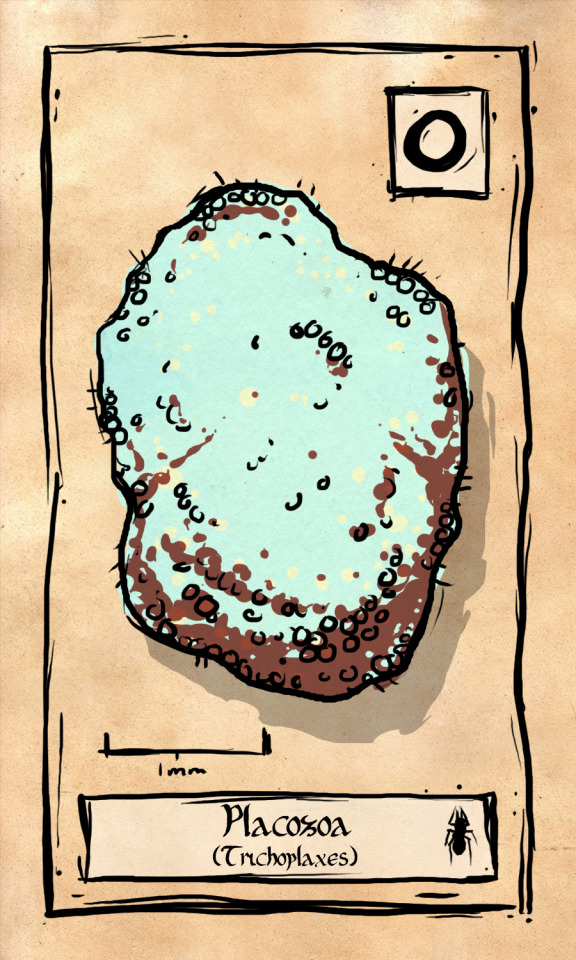
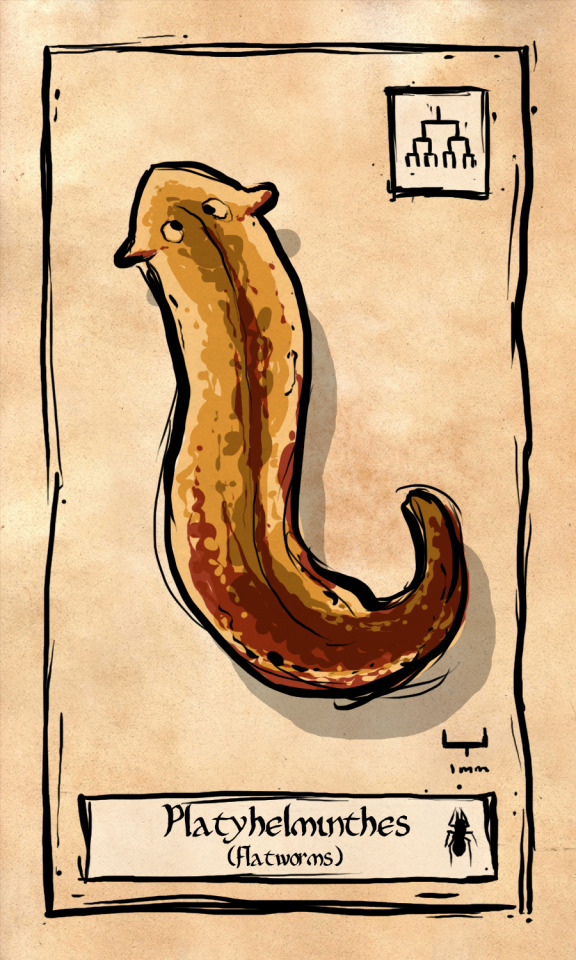
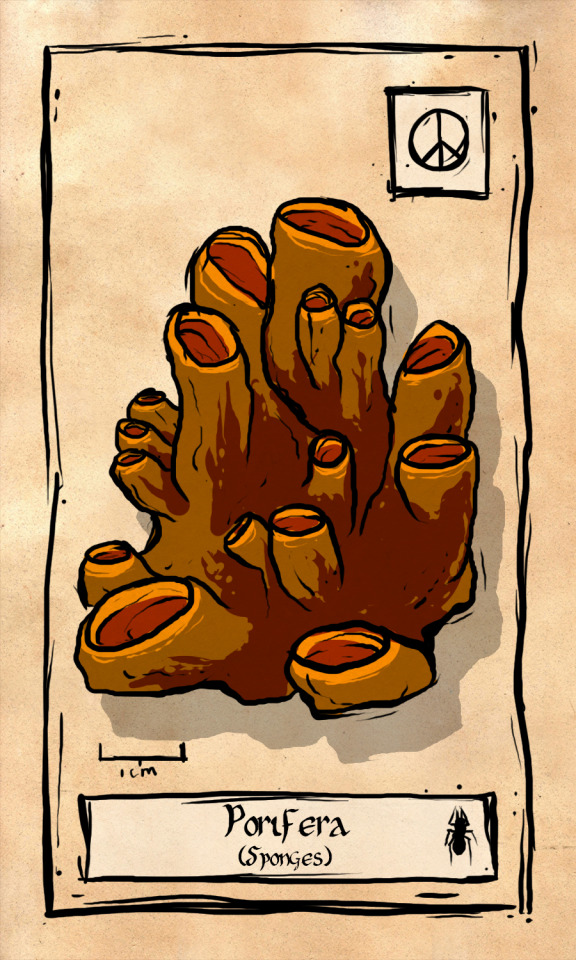

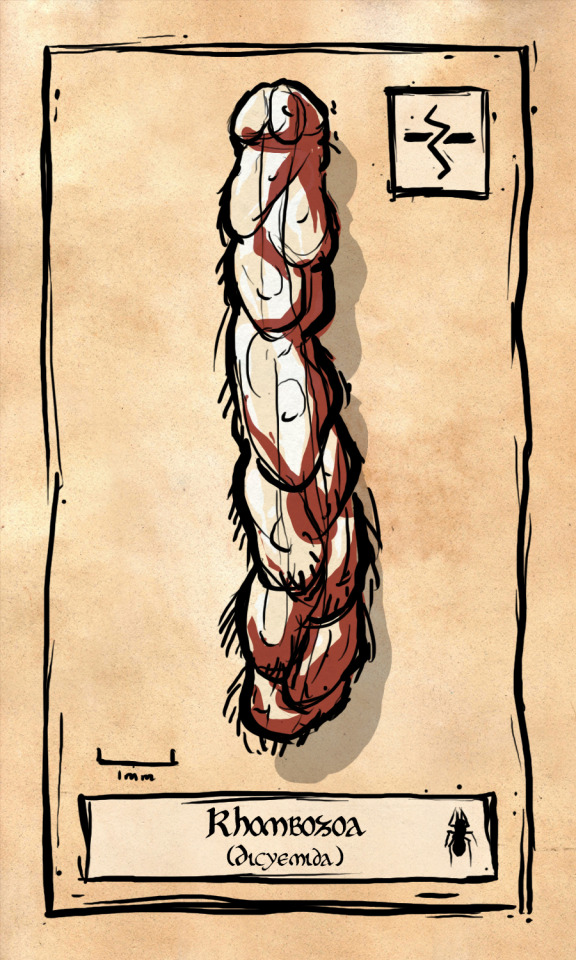
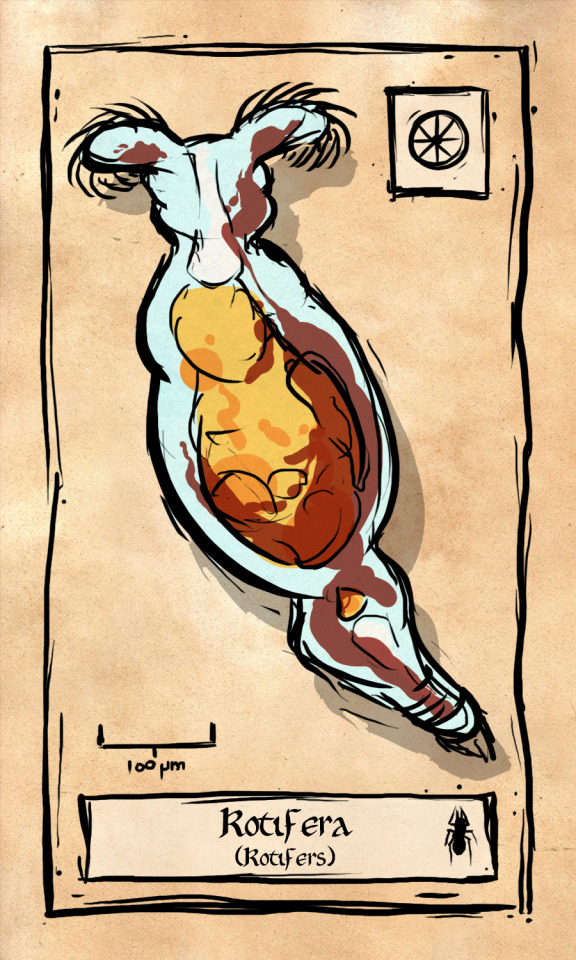
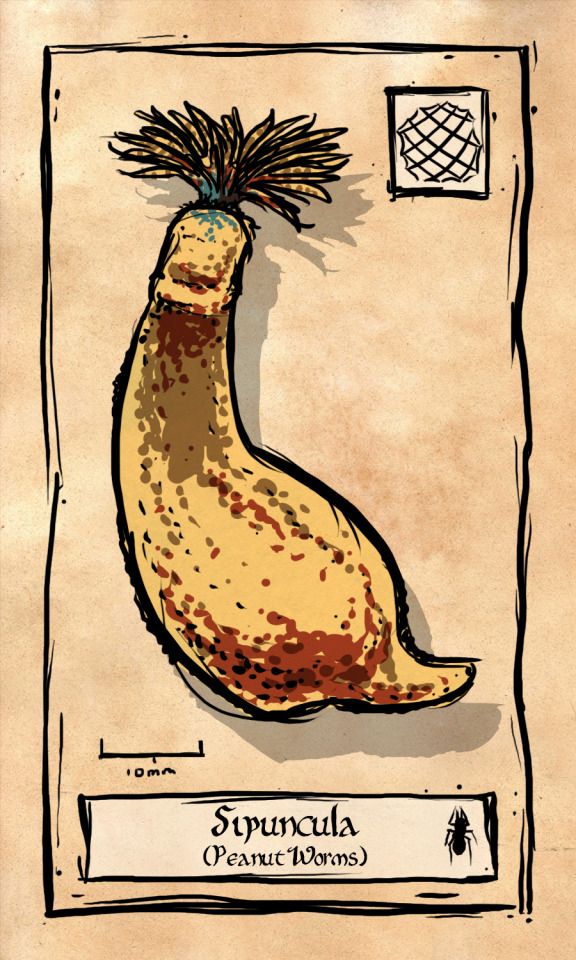
Card descriptions below the cut:
Phoronida – The Horseshoe Worm card represents a return – something that has come full circle to return to its base state. Through change, or perhaps in spite of it, something that has been brought back to light or returned to comfort or perhaps even discomfort. Whether this return is a physical or an emotional one, to home, to health, or a negative one will depend on the subject of the reading. One should tread with caution when return is forecasted, even as a positive, as growth and change are constants in the world of living beings. Phronoids are defined by their u-shaped internal structures that loop throughout their bodies. Both their gut and their bloodstream circle through their body in this way, ending at the same locus of the body.
Placozoa – The Placozoa card represents simplicity. In a reading this should be considered among other elements, and the reading not over complicated by denial and burden. Look to find the most straightforward paths and meanings, and look to find simplicity in life where complexity has overburdened the subject of the reading. The simplest free-living animals in the Kingdom, these animals live and thrive with only four types of cells in their bodies and almost nothing more to their body plan than a top, bottom, and sides.
Platyhelminthes – The Planarian card represents multiple outcomes. While a singular event may seem to be concrete, there are always variations from one singular point. It is not always possible to control these events, but understanding variation that can exist can be critical to understanding an outcome. Embracing variety brings acceptance. When unsure of the outcome of a major or minor event, understand variation, but limit its scope to plausibility. With their simple body plan, flatworms can often survive major trauma, such as bifurcation of the head, by simply growing two heads where once there was one. Despite this change of perspective to the world, the worms remain able to survive and thrive as they inevitably split into two functional individuals from this trauma.
Porifera – The Sea Sponge card represents inner peace. Not just a nebulous form of serenity, but peace from an internally guided source. Looking inward to find a cohesive calm is a tangible and relevant skill at all times, and it may take careful reconstruction of various internal barriers. The sponge, which is both simple and complex, yet can regrow when ground down to its most base cells, is a halcyon of inner peace. With no brain, it lives, and yet does little harm in doing so.
Priapulida – The Penis Worm card represents abundance. As with many other cards, whether this particular meaning is positive or negative is critical to consider within the context of the reading. Abundance can be wonderful when it applies to something of need and value, but abundance can be detrimental when it applies to the over-saturated. Consider where abundance lies in context of the reading, and whether it is something to embrace or step away from. Some species in this phylum may occupy a small area in incredible abundance, their survival strategies allowing them to make the most of favorable environments and produce many offspring.
Rhombozoa – The Dicyemida card represents dispute. In a reading, it may be time to consider where a dispute lies, and be honest in the nature of disagreement. A dispute, argument, or difference of opinion is not, in and of itself unhealthy (although it can be when views are uninformed or cruel) and should be openly considered and allowed to play out as a dispute until a resolution can be reached. When cards in a reading have conflicting interests and meanings and this card is showing, consider where the discrepancy lie, and embrace the differences between them. This phyla encompasses a group of very small and very specific organisms, all renal parasites of squid, although their classification remains in dispute.
Rotifera – The Rotifer card represents the wheel. Wheels turn, they are an embodiment of a perpetual change of states, one to the next to the next, each following the other in an eternal cyclical loop. To live is to change, and yet change comes in cycles, in following forms, in repeated patterns. This is a chance to look at the grater picture of cycles – seasons, orbits, day and night, the repeated and the predictable. Rotifera are so named for the coronal ring which, with its constant motion, superficially resembles a wheel.
Sipuncula – The Fat Inkeeper Worm card represents a net. Creating a net and casting it wide allows to capture many small things at once that may have even avoided capture all together without it. What these small things are depends on the subject of the reading. Ideas? Opportunities? Whatever it is, it may be time to set a net out to catch them up. While the members of this phylum bear a distinct resemblance to a certain portion of human anatomy, their behavior is far more fascinating than a simple phallic comparison. In order to feed, the worm produces a mucus 'net' in its den, filtering water through it, and then consuming it when it is full of prey. It is a highly efficient predator in this way.
25 notes
·
View notes
Photo
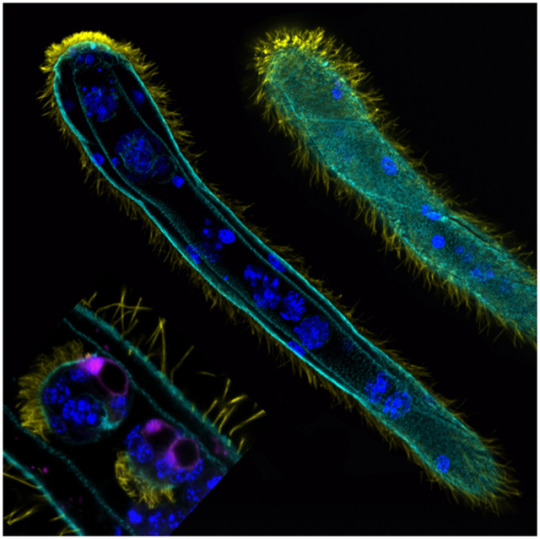
Lessons on Parasitism from the Curious Dicyemida
Research in Genome Biology and Evolution has looked to the “decidedly curious” Dicyemida in attempt to answer an important question: how has parasitism evolved?
Found in the renal sacs of both squid and octopus, this microscopic organism derives nutrients from the host’s urine and has been categorised within the group Spiralia, along with flatworms and molluscs.
Using sequencing technologies to analyse the genome of Dicyemida, researchers sought to provide further insight into this “odd organism” and revealed that, like other parasites, it has a reduced genome, with only ~5,000 genes.
Find out more about the strange Dicyemida and what effect this loss of genetic material has on its fundamental functions.
#Genome biology and Evolution#evolutionary biology#mesozoa#genomic analysis#microscopic organisms#life science#oxford university press#oxford journals#spiralia#dicyemid#hox genes
42 notes
·
View notes
Text
Fwd: Postdoc: CzechAcadSci.PhylogenomicsPopulationGenomics
Begin forwarded message: > From: [email protected] > Subject: Postdoc: CzechAcadSci.PhylogenomicsPopulationGenomics > Date: 11 July 2020 at 07:28:57 BST > To: [email protected] > Reply-To: [email protected] > > > *18 month postdoc position: Phylogenomics & population genomics (6 month > extension possible)* > > Laboratory of Molecular Ecology and Evolution (Biology Centre, Czech > Academy of Sciences and University of South Bohemia, Czechia) has funding > for a Junior Researcher (postdoc) in the fields of phylogenomics & > population genomics. > > We are reopening a call for a postdoc position (a previously selected > candidate could not join the lab due to covid situation in their home > country). > > We are looking for an independent junior researcher with interest in > evolutionary biology and strong background in bioinformatics and > analyses of phylogenetic and population genetic data. Knowledge of > Linux/unix and experience with scripting & programming languages > (Python, R) and phylogenetic inference using WG data is necessary. > Experience with population genomic and genome assembly and annotation > pipelines is beneficial. A good publication record is important. The > applicant should be able to coordinate a team of 2-3 students and have > well-developed communication skills. > > *Job description:* > > This research position will include (mainly drylab) work on two grant > funded projects: > > 1)Phylogenomics (and species diversity survey) of Dicyemida, an enigmatic > group of parasites from cephalopods (60% job time allocation). > > 2)Population genomics of adaptation in parasites. The project studies > interaction between host specificity, genomic differentiation, and > adaptation in a freshwater parasite (Ligula intestinalis)(40% job time > allocation). > > On the 1st project, the postdoc will be responsible for designing the > research strategy (amplicon sequencing design for species diversity > survey, selection of tools for extracting data from wg datasets) and for > analyses of obtained data (transcriptome assemblies, amplicon assemblies, > mining and filtering genes into matrices, phylogenetic reconstruction). On > the 2nd project, the postdoc will provide assistance with analyses of > population level NGS data (whole genome re-sequencing data, RADseq, > SNP calling, demographic inference, analysis of selection, etc.). > > The postdoc will co-supervise one phd student and will be free to > supervise undergrad students if desired (a valuable experience). There > is an opportunity to take part in teaching, in field collecting trips, > and in other popgen projects running in the laboratory (incl. publication > output). > > *We offer:* > > We are a relatively young but quickly developing laboratory with interests > in evolutionary and ecological interactions between organisms and their > environment. We use genetic (increasingly more genomic) data to answer > the questions (e.g. https://youtu.be/xvHSjEi0c44?t=7051). > > We have advanced computing resources available both in-house (> 300 > nodes) and via a connection to the national grid (> 20,000 CPUs). The > lab collaborates with institutions/labs abroad (e.g. University > of Alabama [Kocot lab], University of Illinois [Catchen lab], > University of Saskatchewan & Cornell [J.A.Andres]) and we co-organise > the biennial Workshop on Population and Speciation Genomics ( > https://ift.tt/2KrOOdO). > > Biology Centre is a dynamic institution with a strong international > community of junior researchers and an “HR Excellence in Research” > awarded institution. It is located in the centre of a university > campus. English is the working language at the institution. The city > of Ceske Budejovice is a charming historical city, has great outdoors > nearby, and it is located within easy reach of the capital, Prague, > and several cities abroad (Vienna, Linz, Passau). > > Funding is guaranteed for 1 year, with extension for another year, > based on performance. The salary is approx. 30% above the Czech average > income, it is sufficient to cover all necessary living costs with a margin > (Czechia is a developed, yet relatively cheap country to live in). Biology > Centre offers multiple employee benefits (fully covered health insurance, > subsidised lunches, cultural/health programmes, etc.). > > In case of questions, enquire using the contact info below. > > *Applications:* > > Applications should be prepared as a single pdf containing: > > a CV (with publication list) > > a detailed statement of research interests > > names and contact information for 3 references. > > Applications are welcome before August 31, 2020, sent by email to > Associate Prof. Jan Štefka at [email protected]. Prospective > candidates will be interviewed in September. > > The position can be filled starting January 1, 2021, but even an > earlier or a slightly postponed start is possible. > > Jan Štefka, PhD > > Laboratory of Molecular Ecology and Evolution > > Institute of Parasitology, Biology Centre, Czech Academy of Sciences > > Branisovska 31, Ceske Budejovice, CZECHIA > > https://ift.tt/2MqYxkJ > > http://jstefka.info > > Jan Stefka > via IFTTT
0 notes
Text
Parasite Revealed: New Insights into Dicyemida
Parasite Revealed: New Insights into Dicyemida
Revealing the origin and evolutionary history of the world’s manifold life forms is one way in which we seek to understand them. Even the smallest inhabitant can yield fascinating insights. For example, take the Dicyemida, which are microscopic parasites that live inside cephalopods such as octopuses and cuttlefish. These seemingly inconsequential beings have baffled taxonomists due to their…
View On WordPress
0 notes
Text
Parasite revealed: New insights into dicyemida
Researchers have decisively classified the marine parasite Dicyemida, yielding new opportunities for understanding parasites and evolution. Latest Science News -- ScienceDaily https://www.sciencedaily.com/releases/2017/07/170718085228.htm
0 notes
Text
Official Phylum Bracket!
Below is the official matchup list for the Phylum rounds!
There are 33 phyla in the Showdown lineup, so after the polls close on Round 1, the winner of Xenacoelomorpha vs. Hemichordata will go up against Micrognathozoa in Round 1.5 before we move on.

How this bracket was created:
After assembling the list of phyla, I ranked them based on my best guess of how they would perform in the polls. I then split the list into the Top 16 and the Bottom 16 (minus Micrognathozoa), and created a bracket for each half using this site. I split up the list because it felt unfair not to give the less charismatic phyla at least a chance to compete! I've been affectionately calling the Bottom 16 matchups the "Micro-Royale" :) From there, I created a new bracket, alternating matchups between the Top 16 and Bottom 16.
Since Tumblr is probably going to crunch the image quality, the bracket matchups are listed in text format below the Keep Reading.
Round 1:
Round 2:
Arthropoda vs. Brachiopoda
Priapulida vs. Placozoa
Platyhelminthes vs. Onychophora
Loricifera vs. Gastrotricha
Annelida vs. Nematoda
Cycliophora vs. Gnathostomulida
Phoronida vs. Cnidaria
Dicyemida vs. Chaetognatha
Mollusca vs. Bryozoa
Nematomorpha vs. Orthonectida
Nemertea vs. Ctenophora
Acanthocephala vs. Tardigrada
Echinodermata vs. Porifera
Rotifera vs. Kinorhyncha
Entoprocta vs. Chordata
Xenacoelomorpha vs. Hemichordata
>> (Micrognathozoa will challenge the winner of this matchup)
Arthropoda vs. Placozoa
Onychophora vs. Loricifera
Annelida vs. Cycliophora
Cnidaria vs. Chaetognatha
Mollusca vs. Nematomorpha
Ctenophora vs. Tardigrada
Echinodermata vs. Rotifera
Chordata vs. Micrognathozoa
Round 3:
Arthropoda vs. Onychophora
Annelida vs. Cnidaria
Mollusca vs. Ctenophora
Echinodermata vs. Chordata
98 notes
·
View notes
Text
Round 1 - Phylum Dicyemida

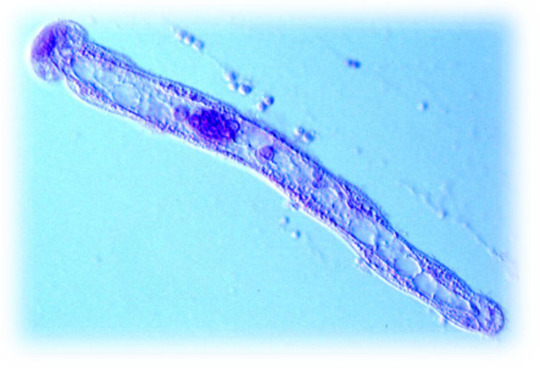

(Sources - 1, 2, 3)
Another small phylum of parasites, Dicyemida contains microscopic animals that range from 0.5 to 7 millimetres long and live in the renal appendages of cephalopods.
Dicyemids lack respiratory, circulatory, excretory, digestive, and nervous systems, and consist of a single axial cell surrounded by twenty to thirty ciliated cells. Unlike many other parasites, they don’t seem to be picky about which species they infest, and dicyemids of multiple different species can often be found infesting the same host. Yet, two individuals of the same species can rarely coexist in the same host. This seems to indicate that different species of dicyemids occupy different niches within their cephalopod host. Species are generally differentiated by the shape of their calotte, the region of the animal that is used to attached to the host. Different calotte shapes determine where in the renal appendage the dicyemid can comfortably live.

Propaganda under the cut:
The fact that dicyemids do great sharing space with other species of dicyemid, but not with their own species, gives them a certain “I prefer animals over people” and I love that for them
It’s just nice to know that even octopodes can get worms. No one is safe from parasites, and I think that’s beautiful.
That being said, though, dicyemids don’t seem to do any damage to their hosts. They just kinda chill inside them. In fact, dicyemids may actually help the cephalopod by absorbing harmful metabolic waste products and improving the flow of urine through the kidney!
Th
They
They in that octopussy
25 notes
·
View notes
Text
Also, I’m reading up on the phyla I was drawing and… am I misunderstanding something, or do dicyemids have alternation of generations?

0 notes
Text
COME ON DICYEMIDA!!!!!!
Taxonomy Tournament: Spiralia


Dicyemida. This phylum is made of tiny parasites that live in the kidneys of cephalopods
Monoblastozoa. This phylum of animals has only one member, Salinella salve, which was only ever described in the 1890s and hasn't been found since.
38 notes
·
View notes
Text
Congratulations to the Phylum Round 1 winners!
The lucky phyla that will be moving on to the next round will be: Arthropoda, Placozoa, Onychophora, Loricifera, Annelida, Cycliophora, Cnidaria, Chaetognatha, Mollusca, Nematomorpha, Ctenophora, Tardigrada, Echinodermata, Rotifera, Chordata, and Xenacoelomorpha.
*** As a reminder, before Round 2 begins, Xenacoelomorpha will be going up against Micrognathozoa first. ***
Here are some fun facts about Round 1!
The top 3 closest matches were Xenacoelomorpha vs. Hemichordata (1%), Nematomorpha vs. Orthonectida (5.2%), and Onychophora vs. Platyhelminthes (14%).
The top 3 matches with the widest margin were Dicyemida vs. Chaetognatha (80.8%), Acanthocephala vs. Tardigrada (76.8%), and Cnidaria vs. Phoronida (74.4%).
The most-cheered-for phylum was Platyhelminthes, with roughly 46 positive comments. This is followed by Mollusca with ~30 positive comments.
The least-cheered-for phyla were Kinorhyncha, Acanthocephala, and Loricifera, with roughly 1 positive comment each. (Note that I may have misunderstood some people's responses, and I didn't count responses that were not actively positive. My count is subjective!) Don't worry, they'll be okay! In my scientific opinion, these little guys know they are very loved. <3
Highlight reel and summary of Round 1 below the Keep Reading!
This bracket includes a lot of phyla that many people were not aware of beforehand! There was a lot of marveling over these unfamiliar animals, summed up very well by @transcyberism and @space-candy:


Arthropoda was, predictably, a pretty popular phylum, so folks (@moonchopsticks, @rotationalsymmetry) had some sympathy for its opponent, Brachiopoda:
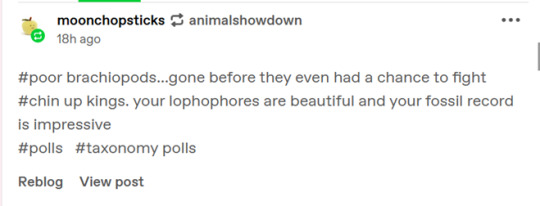

There was quite the outcry when folks realized that Echinodermata and Porifera had been pitted against one another! Much ruckus was raised over unintentionally pitting two bad bitches against each other. The scandal can be summed up neatly by @dumbratinjade, @ploridafanthers, and @capripian:

As Chordata surged forward in the polls, many folks (@luncheon-aspic) had suspicions about the reason behind its success:

Some of the more niche phyla got some love! A small selection... Proof of the absurdity of the animal kingdom (@qsatisfaction):

Our ace champions (@oracle-moment):

Star Wars ass creatures (@jupesontherun):

The most relatable sentence to me, rosybetta, known intertidal mud flat enjoyer (@ploridafanthers):

Overall this round was a huge success! To everyone who sent in propaganda, thank you! All of us learned so much!
60 notes
·
View notes